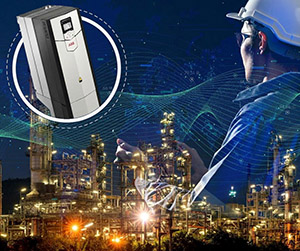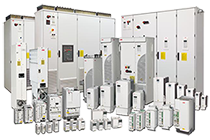Did you know that 65% of the average UK electricity network is consumed by induction motors? These powerhouses of industry, induction motors power a multitude of applications from food factories to huge power plants. From applications such as conveyor belt systems to the fan and pumps responsible for the heating and ventilation systems within the buildings, induction motors are all around, working in unison to power production and to keep our working / social environments habitable.

Unfortunately, and perhaps without awareness, businesses are consuming more energy than required, 95% of motors have been initially oversized on the principle of “just in case”. Just in case our application becomes bigger, just in case we need to ramp the speed up, just in case the production becomes strained. This has led to a multitude of oversized motors nationally.
How can savings be made?
To discover the potential power savings, let's look at an example of an average-sized motor of 45kW that runs 24 hours a day 7 days per week, at an average cost of 23 p/kwh. This would cost the company, for one single motor, £90,666 per year. As most motors have been oversized by approximately 20%, the scope for savings here is significant. Businesses could save thousands every year by using variable speed drives (VSDs) on centrifugal fans, pumps, and compressors. Taking the aforementioned motor as an example, implementing a VSD that slows down the motor by 10% would result in 27% energy savings. Financially, this would provide an estimated payback of £24,479.82 per annum, for energy savings of 106,434 kWh. An average household consumes 3,100kwh per year, meaning the savings would equate to 34.33 homes per year not using electricity; carbon savings would equal 15.53 tonnes per year.
The average site will have more than one motor with energy-saving potential. In this example, let’s say there are 10 motors: the savings would approximately equal £244,798.20 per annum, turning off 343 households’ worth of energy, equivalent to potentially an entire estate’s worth of housing. All this saving with an investment of approximately £45,000.
Energy prices are at an all-time high! They have doubled in the past 10 years with it set to increase further still. It’s more important than ever before to focus on where savings can be made.
Zero Net Carbon - Variable Speed Drives & PID Loops
Industry plays a critical role in “achieving Net Zero by reducing energy consumption.” Now when we contemplate how we will meet the carbon savings for Zero Net Carbon, the most considered factors seem to be technology such as energy-saving lighting or even renewable energy. But why are we looking to produce renewable energy simply to waste it on an inefficient network?
In the specialised industry relating to ATEX-certified products, the information surrounding the correct usage of motor packages can be quite difficult to understand. The complex regulations and best practices surrounding these products thus lead to problems with incorrectly sized motors and VSDs used. Especially in cases where you are an original equipment manufacturer, your area of expertise lies with the equipment you design and build, not necessarily ATEX certification of hazardous area motors and the correct sizing with the variable speed drives. Issues with lack of compliance may also arise from the challenge of getting lost in extensive paper trails, an understandably confusing process.
Utilising Technology
Working towards the standards of Net Zero Carbon, we must understand the pre-existing technology within our industrial institution’s and how to operate it more efficiently. By utilising this technology, we can optimise energy savings further by simply turning down a variable speed drive using a PID Loop. This is a feedback loop that communicates directly to the VSD the exact amount of energy needed to power the motor for the process.
Working similarly to the feedback loop when driving a car: you are checking your surroundings and assessing the amount of power required for the given speed - you accelerate when needed and decelerate to slow down. The PID loop within the VSD works in the same way. Using a sensor in the ducting, the pressure is always being measured, feeding back information continually to the variable speed drive. If the pressure drops it tells the motor to speed up, while if the pressure is too high it tells the motor to slow down. This provides the exact marriage of power needed, meaning you will only ever consume the necessary amount of energy required, making this the best-optimised energy solution available for VSDs.
Power and Energy Savings
Contrary to constant torque applications, where power saved equates to energy saved. Variable torque has the advantage of working within the principle of the cube law, the power reduced here is disproportional to energy saved. Unlike the linear savings in high torque applications where 10% power saved equates to 10% energy saved, the fan/pump curves dictate energy savings to a greater nature:
- 10% Power Savings = 27% Energy Savings
- 20% Power Saving = 49% Energy Savings
- 30% Power Saving = 66% Energy Savings
These savings could be increased further still - induction motors that have been running for years that may be of a lower efficiency are themselves inefficient. Utilising the variable speed drive can of course change this, however, technology has advanced with higher efficiency induction motors available.
ABB has also released an IE5 motor, the synchronous reluctance motors (SynRM). These motors have been designed differently from those of older induction motors, with the sophisticated design of the VSD paired with the SynRM. In a nutshell, there is less ‘slip’ through heat losses or noise within the motors, giving even further savings of 3-4% depending on the application.
So, why is the AC induction market still infiltrated with old technology?
So, the ultimate question is: when efficiencies and energy savings are so easy to achieve for the AC Induction motor market, why is it still infiltrated with old technology? At Halcyon Drives, we aim to supply these efficient innovative technologies to companies in the industry, working towards Net Zero Carbon.
Not only can we provide the engineering excellence to help reduce your energy, but we are also prepared to prove them to you before you invest a single penny. Our fleet of hire drives, which ranges up to 1MW in size, is available on a next business day basis. This can be installed to provide you with before and after readings.
With energy prices rapidly, there has been no more critical time than present to reduce costs and carbon. We don’t just have the potential to turn off the entire town’s worth of electricity, we have the potential to turn off entire cities.

